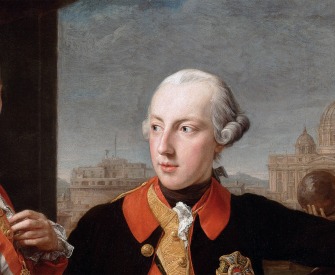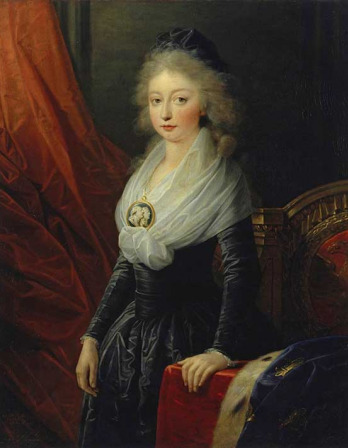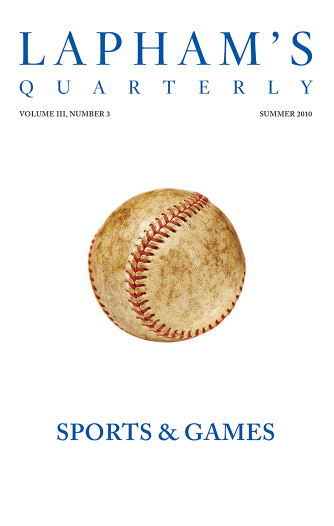The most remarkable and strangest thing we saw in the House of Physics was a force that carries news from one place to another in an instant with complete clarity and accuracy, even if the two places are far apart, because it is done with writing. The way they did it was with a disk of brass like the face of a clock, engraved with all the letters (and the vowels too, because the vowels are letters for them). This disk was firmly fixed to a stand, which had as many holes in its sides as there were letters, a hole under each letter. Across from it was another disk, lying flat, that was also marked with all the letters, with a pointer at its center. The two disks were connected by two wires that vibrated. If one person wished to talk with another, he would turn the first disk so that the needle lodged in the hole below the letter desired; the pointer on the second disk would stop at the same place. So it went until the words were complete and perfectly understood—all with the greatest speed. They claim that the force between these two disks can carry words instantly from one place to another. Even if there were thousands of hours of travel time between them, it would take just a second, that is, one-sixtieth of a minute.
This device completely staggers the senses, but one who has seen it with his own eyes will not doubt it. We tried it ourselves with a few words and could not move our eyes from one disk to the other before the pointer stood at the correct letter. They claim that they have set this up between Paris and Orléans, a distance of ninety miles, and also between the chamber where they gather to make their laws and the palace of the sultan, by means of a device hidden underground with an attendant at each end. They talk to the sultan from the chamber while he is in his palace, and he answers them, although they are a great distance apart.
On Thursday, the twenty-third day of the month, we went to the house for printing books called the “astanbā,” which is another of their amazing crafts. First of all, you should know that the letters are cast in tin, thick at the bottom and narrow at the top. Some letters are single, and others are made of two letters joined together. The printer takes the letters he wants and puts them in a frame the size of the page to be printed, setting them in straight lines like writing. The letters are held tightly with a clamp that keeps them in order. Then they coat them with ink and lay a sheet of paper over them, pressing it down firmly by means of a vise. When the paper emerges, it is completely covered with writing. This is a general description of it. Now let me tell in detail about what we saw in this place.
First we entered a room with an oven where the workers cast the letters in copper molds the size of the type; the letter is engraved on the bottom of that mold, like the letter “sīn,” for example. When the melted tin comes out, the letter at its head is reversed, but when they print with it, it comes out straight like any stamp. These workers cast letters in many types, both Arabic and non-Arabic. In the next room there were many workers, more than in the first; their task was to straighten and polish the letters, removing the bumps so that they would fit smoothly together in the frames. There were others who sorted the letters into compartments, one for each letter.
Next came the room of the typesetters. Sitting before the book to be printed, the typesetter takes the frame and arranges the letters in it just as they are on the page. He sets down the first line on a metal rule and puts it in the frame, then he composes the second line, and so on until he fills the frame. Even if he does not understand the writing and cannot read it, he knows its equivalent in type. We tested one of them by writing out a line in Arabic, and he set it down exactly. We told him to break it up, which he did, and there were thirty-four letters. Then he returned each to its place swiftly and without a mistake. This completely astonished us.
Once the type is set in the frames, it goes into the hands of others. We entered a room in which there were large open tanks of water with bundles of paper resting on their edges. Here they soak the paper in water, four or five pages at a time, and set it on the edge of the tank to drip off. Then it goes into another room with machines and rollers worked by a fire you cannot see which dries the papers. Each machine is run by three women workers: one puts the wet paper into the rollers, another turns the rollers, and the third takes it out, completely dry from the heat of the fire inside.
Then the sheets of paper and the frames go to the printing room, where there are two types of printing: one is by hand, the other by rollers. The first requires three people. One worker takes the frame with the letters and sets it in place. The next has a piece of leather in his hand, folded over several times and coated with ink, which he passes over the letters to blacken them. Their ink is not liquid like ours but gives color nevertheless. The first worker then takes a blank sheet of paper, putting it on a second frame which is pressed down on the letters from above by means of a heavy iron device that moves with a turning motion. Then they open it up and out comes the printed sheet, which a third worker removes. With these letters they can print as many pages as they want, a hundred, a thousand, or ten thousand, all exactly alike. They do the same for every page, until they reach the last page of the book. The day a book is completed, it may come out in a thousand copies. If all the necessities are on hand, and no difficulty is encountered in the printing, two hundred or more pages can be printed in a single hour.
After a book is printed it must be bound, and that too is a craft there. They take it into other rooms where they trim the margins of the pages by means of steam power, which operates the knives. In another room they gather the papers in a bundle between two boards, and press them from below with an iron bar moved by water power. Yet another room is for binding. In sum, paper enters this place blank and comes out a bound book.
The total number of workers employed in that establishment was eight hundred, and they work continually, without a stop. One wonders, where do all these books go? But everything there is recorded in books; no place is without them. They take down information and benefit from it, not depending on memory for fear of forgetting it.
© 1992 by the Regents of the University of California, used with permission of the University of California Press.
Muhammad as-Saffar, from an official account of his trip to France. Serving as the secretary to the Moroccan ambassador, as-Saffar traveled to Europe in 1845 and 1846 and recorded his impressions of French society and industry; he was impressed by the railway, which he referred to as the “road of iron.” He also noted the French desire for news national and international, for which “they have the gazette”: “The owner of a newspaper dispatches his people to collect everything they see or hear in the way of important events or unusual happenings.”
Back to Issue




